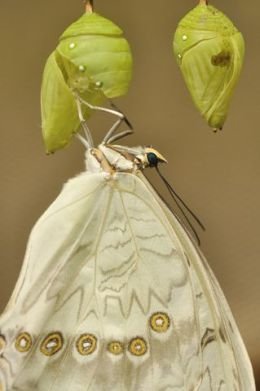The Emerging Butterfly -
Is the Adult Butterfly
The last stage in the life cycle - The Emerging Butterfly

|
|
|
|

|
| Photo: Stanislav Duben |
If the butterfly pupa should be detached and fall from its pupatation spot and survive, it is very important the newly emerged butterfly safely re-orient itself to its environment. The head must be in an upward position with the wings hanging down for the blood to fill in the veins of the butterfly wings.
Flowers are equally as important as butterfly host plants. The newly emerging butterfly can start to rebuild its strength with the nectar provided by the flowers if they are close by.
Butterflies are primary consumers, or feed on plants. Ideally you'll want your butterfly garden to have different nectar sources available from early spring through the fall. This way if any butterfly species experienced diapause or hibernation, once the butterflies eclose they have food.
The butterfly is classified as Lepidoptera and is diurnal. Diurnal is any insect or animal species that are active during the day.
Adult butterflies have a schedule that they adhere to daily, called a Trap Lining, and like most flying insects are especially active in the mornings. Most butterflies start flying after 8:00 A.M., daylight savings time. Warmer climates have butterfly species that will start their day earlier than this at 6:00 A.M.
Daylight is important because butterflies are cold blooded. Not having any internal mechanism that keeps their body temperature constant, it is necessary to bask. Basking is when butterflies rest on an open area taking in the sun's rays. This is necessary as butterflies can't fly when it is too cold.
Basking is one thing that butterflies around the world have in common. Butterfly environments can be hot, cold, dry, moist, found in the highest of mountains or at the lowest of sea levels. Regardless of where a butterfly comes from..
..they all have one thing on their butterfly minds..

Adult Butterfly Mates to Reproduce
and Expand their Species.
Once emerged from the chrysalis, the adult butterfly is an imago. Imago is any insect ready for reproduction. That's when all that butterfly mating starts. In between butterflies need to eat and that's where we come in!
More emerging butterfly information:
- The number for butterfly species worldwide is not certain. At the low end it is estimated to be 15,000 all the way to 28,000. It is estimated for the Lepidoptera family - butterflies and moths combined - is approximately 165,000.
- Holometabolous is also another term to describe complete metamorphosis within four stages. These four stages include the egg, larva, pupa and adult stage. Included with butterflies are insects such as beetles, flies, ants and bees.
- Did you know that not all insects undergo a complete metamorphosis?
Hemimetabolism is an incomplete metamorphosis. In this case some insects go through three stages before emerging - The egg, the nymph (an immature invertebrate), and the adult stage. Development is gradual where there is no pupal stage where metabolic activity takes place, as with the butterfly.
- The opposite of a Diurnal species is Nocturnal, or those who are active at night.
Related Articles:
Butterfly Egg Stage - After imago's mate what happens?
Butterfly Larva Stage - Also called the caterpillar stage.
Butterfly Pupa Stage - The third stage in complete metamorphosis.
Back from Emerging Butterfly to home page Easy Butterfly Garden
 Copyright © 2010-2022 Easy-Butterfly-Garden.com
Copyright © 2010-2022 Easy-Butterfly-Garden.com
Privacy Policy Disclaimer

Join Easy Butterfly Garden on Facebook
Recent Articles
-
Annual Bluegrass
Jan 14, 17 08:14 PM
Annual bluegrass (Poa annua) is considered a weed in the Poa family, which has a few popular turf grasses. If this gets into your butterfly garden listed are a few ways to eradicate it.
-
Candytuft Flowers
Sep 25, 16 10:54 PM
There are the annual, or Iberis, candytuft flowers and also perennials which are called Iberis sempervirens.
-
Keeping Deer Out
Sep 19, 16 01:10 PM
Reviewing the types of products available for keeping deer out of our gardens along with building fences. Many of these products help with other garden pests.
-
Butterfly Meadows
Sep 19, 16 12:52 PM
Compared to other wildlife gardening, butterfly meadows take time and are not for the faint of heart.
-
Natural Gardening
Sep 19, 16 12:32 PM
Natural gardening includes different types of gardens. These garden types create a casual, natural envirionment and help sustain native wildlife which includes butterflies.






New! Comments
Have your say about what you just read! Leave me a comment in the box below.